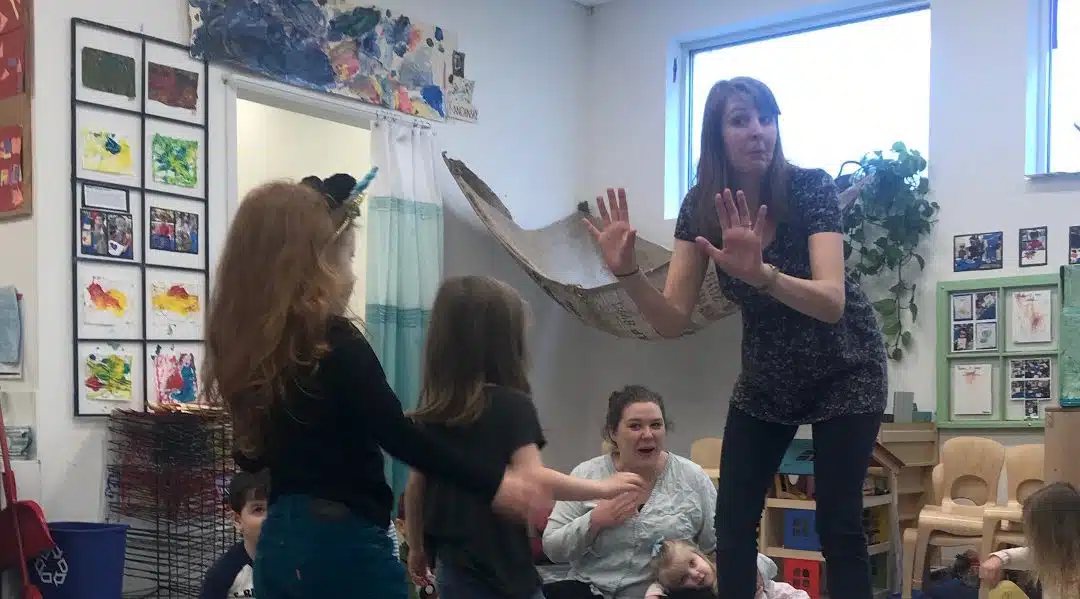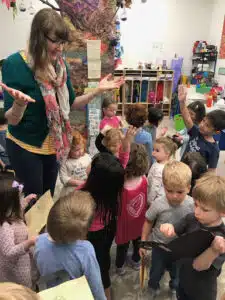Like several Bubbles teachers, I have a background in improv: the art of making it up as you go along! This has been joyfully satisfying in my artistic and personal life as well as incredibly useful in my work with children. I’ve been teaching improv to kids and adults at Second City for the last six years, but by far the most improvising I do is with the preschoolers in my classroom at Bubbles Academy’s Arts Integrated Preschool! I imagine you are also in the habit of constantly improvising with your little one; whether you realize it or not!
Improv is built on the concept of “Yes, And”. If you say “No” when pretending, it comes to a screeching and disappointing halt, so we say “Yes!” ( it’s made up- why couldn’t you be dragons surfing?!). The “And” is even more important. It’s not just enough to agree with someone else’s ideas, you have to add in your own for it to move forward. Collaboration is at the heart of improvisation. You can’t really improvise alone (well technically you can, but it’s pretty rough). What better way to teach prosocial skills?
In some ways, kids are awesome improvisers- they are playful, silly, unselfconscious, imaginative and can get on board with an idea quickly. In other ways, they are tougher scene partners; maybe more resistant to someone else’s ideas and less interested in listening! The idea of surrendering their own idea for another person’s does not come easily to many kids (or some adults for that matter!).
Improv is a skill you can cultivate; both within pretend play and for a larger approach to life. I think there’s so much to be gained for both you and your little ones. It can bring joy, and help keep you sane, while just being present together! While you are surely improvising throughout the day in how you play with your child, and with how you get through the day, here are some improv specific games you can try at home together! While these are geared towards children ages three years and older, you can certainly take the “Yes, And” spirit into all your play with children of any age!
Point and Untell
Walk around the room and point at something. You then say what it is out loud. Here’s the catch: you can say anything but what it actually is! For example, I could point to my laptop and outloud say “Mac and Cheese”. You continue for 30 seconds to a minute “naming” as many things as you can.
How did that go for you? What was tough? What came easily? How about for your little one? Was it silly?
This game works on a very important skill called flexible thinking, but it takes work for our little ones (and for adults too!). This is an exercise that can mix things up for everyone and bring you straight into the present moment. You’ll find that when you play this game, you don’t have much brain space available to worry about anything else!
One Word Story
This one is just as simple as it sounds! You can go back and forth with your little one (or in a circle with the whole family) and tell a story one word at a time. The goal is that the story makes sense even though it can be about nonsense! For example, you want to make a full sentence, but the sentence can be seriously ridiculous! For a variation you can do one sentence at a time or one word, then two words then three words! This is also a good game for car trips.
My favorite part about this one is that you have to listen very carefully to each other and can’t just wait for your turn to talk (which I can be so guilty of!). The other lovely part is that the funniest things happen when you are just listening and building on each other’s ideas!
Yes And Box
You pick up an imaginary box (for extra fun make sure you warn your child not to drop it!) and say “This is a box” and pass it to your child. They say “Yes! And-” and then add one thing to it and pass it back. The game continues like-so. The idea is that you build off the last thing said instead of just naming random things.
For example:
“This is a box.”
“Yes! And, there’s there a unicorn in the box.”
“Yes, and the unicorn is eating donuts.”
“Yes, and the donuts are filled with super sour lemons!”
The box can defy time, space, physics, and history, so anything goes! This is another way to build listening skills for young children. Plus, watching how silly the box becomes, and how it usually ends up being something neither person would have thought of on their own emphasizes those collaboration skills too!
Improv is all about play- which is what kids are experts in!
This is a place for their style to shine. Improv is about using everyone’s ideas no matter how small they are. By creating together, you are showing them that you value their ideas. Play doesn’t stop being important for adults, but it can get harder to make space for. Improvisers rarely say, “I’m going to perform a show tonight.”’ Instead you would say “I’m going to play tonight!”. Being silly and letting loose can be tough as parents; you have to be the patient voice of reason after all. But, by making things up and being silly together, you can show your little one that even though you don’t always know what is coming next, you are always on the same team.
Here are a few resources if you’d like to know more:
Yes Brain
This awesome (and gentle) book for parents, caregivers and teachers embraces the “Yes. And” attitude and has tactics for reconnecting in difficult moments, and finding ways to support your children’s resilience and curiosity as well as your own.
Improvisation for the Theater, By Viola Spolin
This is a deeper dive into improv from the Godmother of Improv, Viola Spolin (Fun fact: her son Paul Sills was one of the founders of The Second City in 1959). As a bit of background, Spolin worked with the Works Progress Administration and later at Jane Addam’s Hull House in Chicago teaching theatre games that were non-competitive, and largely non-verbal to encourage creative expression. She taught immigrant children, few who spoke the same language, and realized she needed to adapt games to cross cultural and ethnic barriers, so everyone could PLAY. I love Spolin and this improv history! While this book doesn’t dive into the history, it does give a great many exercises that Spolin created or adapted. It is weird, wild and wonderful.

Cynthia Bangert
Cynthia Bangert has been with Bubbles Academy since 2014 and is delighted to be the lead teacher in the Jungle Room after wearing many other hats at Bubbles including lead teaching in the Preparing for Preschool Program, assisting in preschool, leading off site after school programs and as part of the event staff. Always drawn to using her imagination and performing, Cynthia has a BFA in Theatre Studies from the University of Illinois Urbana-Champaign where she was also involved in the improv scene. Cynthia received her Early Childhood Lead Teacher qualification from Truman College.
Throughout her career, Cynthia, a Chicago native, has taught kids and teens across the country including at the Idyllwild Arts Summer Program in the mountains of southern California and here in Chicago at the Museum of Science and Industry and with the Chicago Children’s Theater’s Red Kite Program for children with autism. She currently teaches classes at The Second City for kids, teens and adults. She loves to foster a creative, imaginative environment where kids are free to explore, play together and be fully themselves.
Cynthia is delighted to be part of Bubbles Academy Arts-Integrated Preschool where she can use her love of theater, improv and getting messy to inspire courage, curiosity and kindness in her students. Let’s play!

